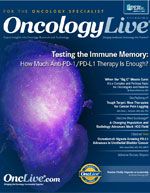Publication
Article
Oncology Live®
The Art of Immunotherapy
Author(s):
There’s no question that checkpoint blockade immunotherapy agents, most notably those directed at the PD-1/PD-L1 pathway, will continue to grow in importance as an anticancer modality in a rising number of tumor types.
OncLive Chairman,
Mike Hennessy
There’s no question that checkpoint blockade immunotherapy agents, most notably those directed at the PD-1/PD-L1 pathway, will continue to grow in importance as an anticancer modality in a rising number of tumor types.
And there’s also no doubt that fresh questions about how best to use these potentially powerful new tools will continue to develop.
Our cover story in this issue of OncologyLive, “Testing the Immune Memory: How Much Anti-PD-1/PD-L1 Therapy is Enough?,” captures one of the most intriguing questions to crop up so far: if one of the advantages of immunotherapy is that it enhances the body’s immune system to fight cancer, then when is it safe to discontinue anti- PD-1/PD-L1 therapy after a response is generated?
Nobody really knows yet, and we’re not likely to know the answer from clinical trial evidence any time soon. As one of the experts we interviewed for this article noted, the duration of anti- PD-1/PD-L1 therapy is being guided right now by patient preference. Some patients prefer to continue therapy until progression while others are willing to halt treatment after they have improved.
It is not surprising that these questions should loom over immunotherapy. Similar questions linger over therapies that have been utilized in cancer treatment far longer than the still emerging class of immunotherapy drugs.
For example, the matter of which patients with chronic myeloid leukemia can safely stop treatment with imatinib (Gleevec)—one of the first targeted anticancer therapies ever approved— remains unsettled.
Researchers recently developed a profile of patients who could consider stopping the tyrosine kinase inhibitor (TKI). Those findings, reported at the 2016 European Hematology Association, provide the most definitive answer thus far to this question—and imatinib was introduced 15 years ago. We’re sure to hear more about this topic before a TKI stop is incorporated into treatment guidelines.
Of course, no one wants to spend more than a decade to find out how long patients should receive anti-PD-1/ PD-L1 therapy. We’re hoping that some of these answers begin to emerge in clinical trials, even if the information comes more as signals than as definitive findings.
This is one of those questions that will confirm once again, at least for the next several years, why the practice of oncology remains as much an art as it is a science.










